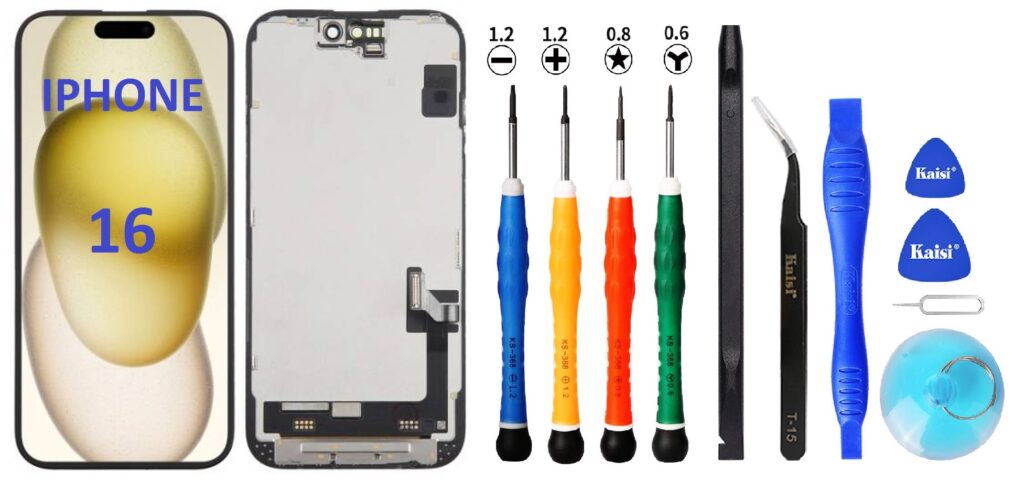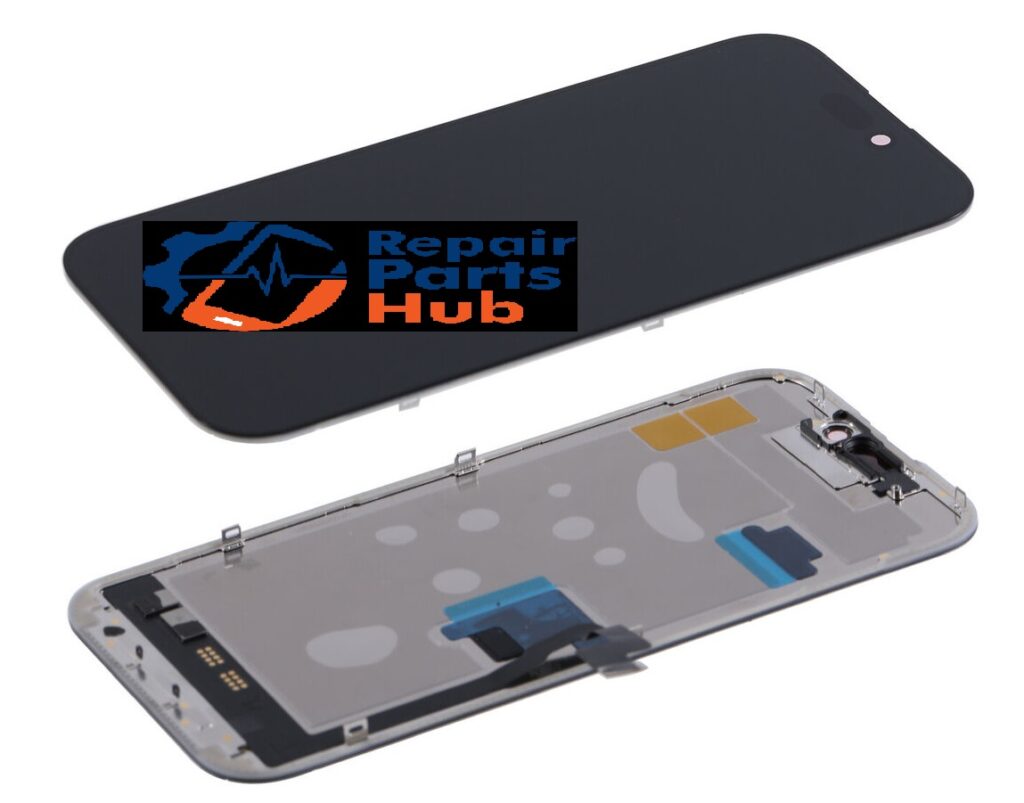
Replacing the LCD screen of an iPhone 16 is a complex but achievable task if performed with precision and using the correct tools. Below is a detailed description of the necessary steps, tools, and screen specifications:
LCD Screen Specifications:
The iPhone 16 features a high-resolution LCD display that offers a smooth and vibrant visual experience. The screen measures approximately 6.1 inches diagonally, with a resolution of 2532 x 1170 pixels, resulting in a pixel density of around 460 pixels per inch (PPI). This display is protected by a layer of toughened glass, often reinforced with Ceramic Shield for added durability.
The replacement LCD screen typically includes the display panel, the digitizer (which enables touch functionality), and, in some cases, the front-facing camera and sensor array, depending on the quality and type of the replacement part. It’s important to note that some third-party replacement screens might not perfectly match the original specifications, so choosing high-quality parts is crucial for optimal performance and screen clarity.
Tools Required for the Replacement:
Replacing the LCD screen on the iPhone 16 demands a variety of specialized tools to ensure that the job is done safely and effectively without damaging the device. Below is a comprehensive list of tools you’ll need:
- Pentalobe Screwdriver (P2): This screwdriver is designed to remove the screws around the iPhone’s chassis. The iPhone 16 uses pentalobe screws near the edges of the device, and the P2 tool fits these screws precisely.
- Phillips Head Screwdriver: Once the pentalobe screws are removed, the internal screws securing the screen and other components may require a Phillips screwdriver for removal.
- Suction Cup Tool: A suction cup is essential for lifting the front screen off the body of the phone without applying too much force, which could damage the display or other internal components. Make sure the suction cup is placed near the edge of the screen to avoid pressure on the display area.
- Plastic Pry Tools or Spudger: These non-metallic tools help to gently detach the screen from the frame without causing any damage to the delicate internal components. A spudger is especially useful for disconnecting delicate cables and connectors.
- SIM Card Ejector Tool: This tool is used to remove the SIM card tray before beginning the screen replacement process. It ensures that you don’t damage the tray or internal components when separating the screen from the phone.
- Tweezers: Precision tweezers are helpful for handling small components, such as screws, cables, and connectors, during the screen replacement process.
- Heat Gun or iOpener (Optional but Recommended): A heat gun or an iOpener is used to soften any adhesive that may be holding the screen in place. Applying gentle heat can make it easier to separate the screen from the body, reducing the risk of cracking or breaking the glass.
- Anti-Static Wrist Strap: An anti-static wrist strap is critical for preventing any static discharge that could potentially damage the phone’s internal electronics while working on it. This safety tool helps keep your device free from static electricity buildup.
- Magnetic Mat (Optional): A magnetic mat is useful for organizing screws and small components in an orderly fashion. This ensures that you don’t lose any parts during the repair process.
Step-by-Step Process for iPhone 16 LCD Screen Replacement:

- Power Off the Device: Ensure the iPhone is completely powered off to prevent accidental short circuits or damage to internal components during the repair.
- Remove the Pentalobe Screws: Use the P2 pentalobe screwdriver to remove the screws around the edges of the device. These screws secure the frame and prevent the screen from coming off too easily.
- Remove the SIM Tray: Use the SIM ejector tool to carefully remove the SIM card tray from the phone, as this will give you easier access to the interior components.
- Heat the Screen (Optional): Using a heat gun or iOpener, gently warm the edges of the screen to soften the adhesive that holds it in place. This will make it easier to separate the screen from the body without causing damage.
- Lift the Screen: Attach the suction cup tool near the edge of the screen and gently pull upward. Simultaneously, use a plastic pry tool or spudger to work around the edges, carefully detaching the screen from the frame.
- Disconnect the Internal Cables: Once the screen is slightly lifted, you’ll need to disconnect the internal cables. Use the Phillips head screwdriver to remove any screws securing the connectors and then gently pry them apart with a spudger or tweezers.
- Remove the Old LCD Screen: After disconnecting all cables and screws, carefully remove the old LCD screen from the phone’s frame.
- Install the New LCD Screen: Take your new LCD screen and connect the internal cables. Make sure all connections are secure and properly aligned. Once everything is connected, reattach the screws that were previously removed to secure the screen in place.
- Reassemble the Device: Once the new LCD screen is installed, carefully align it with the frame of the iPhone 16. Press the screen into place, ensuring it is properly seated.
- Power On the Device: After reassembling the phone, power it on to check that the new LCD screen works correctly, the touch functionality is intact, and there are no issues with the display.
Conclusion:
Replacing the LCD screen on an iPhone 16 requires patience, attention to detail, and the right set of tools. With the proper equipment, including pentalobe and Phillips screwdrivers, suction cups, and pry tools, you can successfully replace the screen. However, due to the intricate nature of the task, it’s important to take your time and, if needed, seek professional help to ensure the device is restored to full functionality without any damage.